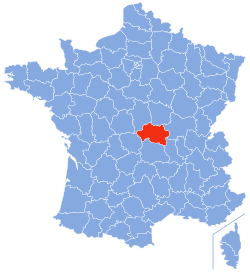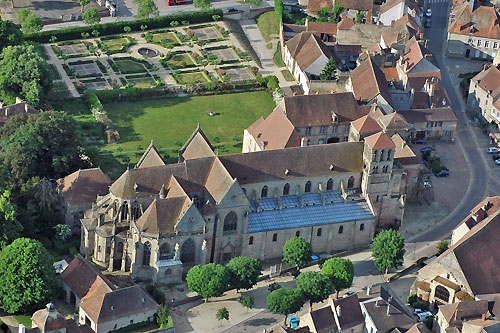 |
| The Independent Traveler's Newsletter PAGE FOUR |
 |
| The Independent Traveler's Newsletter PAGE FOUR |
| FEATURING: THE ALLIER ~ Land of 500 Châteaus | |

It was simply going to be a two-night stopover between the Savoie and our Burgundy and Loire destinations...a place to relax with probably little to do or see. Typically, when something isn't expected as we travel through France, wonderful surprises occur. We didn't realize how much we would fall in love with the Allier, the northernmost département in the Auvergne region of France. We crossed from Burgundy's Saône-et-Loire and very soon arrived at our bed and breakfast near the small city of Moulins.
The Landscape The Allier has six rivers running through it, if you count the eastern boundary with the Loire. There is the Allier, of course, which flows through both Moulins and Vichy, and the Cher where Montluçon is located. But there is also the Sioule in wine country, the Besbre and the Aumance.
Its three large cities are Montluçon, Vichy, and Moulins. Along the rivers throughout Allier are many smaller towns and villages, and it is not heavily populated. Country drives here are delightful! Before the end of the nineteenth century, the population had grown along with industry in both Moulins and Montluçon and the thermal spa attraction of Vichy. Due to losses in World War I, the growth in population stopped and didn't increase again until the 1960s ~ and then only slightly.
Today,
Montluçon's upper town on the banks of the Cher, with its steep
winding streets and buildings from the 15th and 16th centuries, is a favorite
place to visit. The city has many interesting churches, some from
the 12th and 14th centuries, and the castle rebuilt by Louis II, which
today serves as a barracks. And, as with so many towns and small
cities in France, there are always festivals and celebrations taking place.
This past July 7 and 8 Montluçon held its Medieval Festival (more
accurately known as Fête des Ducs de Bourbon et marché
médiéval). This photo was taken during the event
in front of the castle of the Ducs de Bourbon.
In July of 1940, the government of Marshal Philippe Pétain made Vichy the capital of the 'free zone', or Vichy France. The Vichy regime collaborated with the Nazis, but the area it controlled remained unoccupied until 1942 following the Allied landings in French North Africa in early November 1942. To avoid a threat from France's Mediterranean coast, Hitler's army occupied Corsica on November 11 and Vichy the next day.
The Church of St Blaise dates from 1672 ~ only a 19th century chapel remains containing a picture of a Black Madonna and which is now conjoined with Church of Notre-Dame-des-Malades. Each August 15th on the Feast of the Assumption, a procession takes place in Vichy. Notre Dame des Malades is an Art Déco church built in 1931 by the father and son architectural team of Antoine Chanet (he built Vichy's Hotel de Ville) and Jean Liogier. The interior, in comparison to the exterior, is quite ornate and uses marble, onyx and semi-precious stones for mosaics with stained glass windows by the well-known and admired Frères Mauméjean.
There is so much to see in Moulins ~ and it is the perfect town to wander around at your leisure with no particular goal in mind.
Anne de Beaujeu was the Regent of France from 1483 to 1491 and daughter of Louis XI and his second wife, Charlotte of Savoie. At the age of 14 she was married to Pierre de Bourbon, seigneur of Beaujeu, 22 years her senior. He proved to be a supportive husband as she acted as regent for her brother, Charles VIII, during his minority. She and her husband held off the conflict coming from Orléans, and during her regency she was one of the most powerful women of the late fifteenth century and was referred to as Madame la Grand. Today, in Moulins there is the Pavillon and Musée de Anne de Beaujeu, housing archeological and decorative art objects as well as paintings and sculpture. The archeology collection focuses on prehistoric and Gallo-Roman objects, and there is also a military arms collection. In addition, the museum has taken on supervision of the 19th century collections left in Maison Martin by its owner who died in 1905. Several well-known personalities came from Moulins. Among them, Coco Chanel who went to school in Moulins when she was orphaned and who later became a world-renowned fashion designer. It was also the birthplace of the great 19th century baritone opera singer, composer and art collector, Jean-Baptiste Faure ~ not to be confused with the great French composer Gabriel Fauré. The Gastronomy of Allier Allier has some unique gastronomic offerings ~ one being a river fish called ombre des rivières, found rarely anywhere else and prized throughout France for its delicate flavor and texture. There are distinctive specialties in Allier including potato pie (made with fresh cream and potatoes), scratchings bread (butter is replaced by fried pork fat scratchings and extra salt is added), and Bourbon Charolais beef dishes of all descriptions. As you drive through the Allier, you will see the grazing white cattle on every farm. A sweet dessert is Palet d'Or, a Moulins specialty made from semi-sweet chocolate and cream ganache and topped off with gold flakes.
Of course, as with every region of France, there is the cheese! Perhaps one of the best known is Bleu d'Auvergne. Only produced in the last hundred years, the tale of its creation is that an Auvergnat farmer sprinkled bread mold on his milk curd, piercing the curd with a needle. This permitted air to penetrate the curd, and it developed blue veining. Bleu d'Auvergne achieved AOC designation in 1975. It is said that it has the flavor of grassy pastures and wild flowers, and everyone we know who has tasted it, loves it. Another blue cheese is Fourme d'ambert made from cow's milk and Cantal, both from the Cantal département. And from the Puy-de-Dôme, there is Saint Nectaire - one of those delightful semi-soft cheeses with a nutty flavor that everyone enjoys time after time. The Special Places We must return, however, to where we began: entering the Allier to spend a few nights on our way to points north. Our destination was Les Vieux Murs, a bed and breakfast that we knew little about except for what we saw on their web site. It is located in the town of Souvigny in the Allier. As it turned out, our choice of a place to stay couldn't have been better. The owners are delightful and the chambres d'hôtes an absolute dream. Entering Souvigny (our first time ever) our goal at the end of a long driving day was to find their street. Just by chance, as we slowed down to read a street sign, there it was! We made our right turn up a hill and number 11 was an opening in a wall ~ a wall that was continuous: one house after another attached to the next with doorways right on the street. Having remembered from the web site a rather grand home on a spacious piece of open land, we were a bit confused about this small entrance right in town. But, we approached the gate, rang the buzzer, and the gate slowly opened for us to drive in. Before us lay a winding driveway, bordered by trees and lawns, leading up to a fine manor house. It was the nicest surprise of our stay in France. 
The Priory of Saint Peter and Saint Paul and its gardens in Souvigny The village of Souvigny, made a 'great Romanesque sanctuary of Auvergne' in 2003, proved to be very special as well. It has a long history with the Bourbons and the Benedictine monastery at Cluny Abbey. The influence of the Bourbons made Souvigny an important town. In the year 916 Aimard, the first known ancestor of the Bourbons gave the abbot, Bernon of Cluny, his villa in Souvigny and the Priory of Saints Peter and Paul. The fourth and fifth abbots of Cluny, Mayeul and Odilon, are buried at Souvigny, and it always had influence in the Pays Bourbonnais. Their sepulchers, which sank into oblivion during the French Revolution, were rediscovered by archeologists in 2001 and 2002. The priory church became a stopping point on the pilgrimage route to Santiago de Compostela and is a fine example of the marriage of Romanesque and Gothic architectural styles. It was altered several times by the Dukes of Bourbon who introduced Gothic architecture to the heart of France. The town holds many public events of interest to both locals and tourists. A few of those are the antiques fair in May, a Medieval fair beginning on the last Sunday of July each year, autumn music days the last weekend of September, and the regional sale of antiquarian books in November. While in Souvigny we stopped at a little café across from the cathedral for coffee to discover that it was also a book shop specializing in used and collectible books as well as new ones. What we found really interesting were the many Romanesque churches in the local villages, most only a short drive from Les Vieux Murs. Our host and hostess suggested three to visit one morning. With intermittent rain, we set off with two umbrellas to see the churches. Here are some photos of the three we were able to visit.
Nearby, as well, is the town of Bourbon-l'Archambault, a spa town and the origin of the House of Bourbon. In 1300, Louis Bourbon built the city when he was made Grand Chambrier of France. Although it was the capital of the province for some time and achieved great importance in the late 1320s when Charles IV elevated Louis I de Clermont to Duke of Bourbon, either he or the later Pierre II moved the capital of the province to Moulins. We hope this has tempted you to visit the Allier when you are next in France. It is not a typical tourist destination (which is in its favor), and offers the visitor culture, history, tranquility and a completely unique experience. If you have questions, don't hesitate to contact us at info@franceonyourown.com. Where to stay in the Allier: Les
Vieux Murs is set on acres of rolling lawns and woods in Souvigny,
just to the west of Moulins. The first impression is a very good
one, and once you meet your hosts you will know that you have chosen the
ideal lodging place in this lovely part of France. From the Swiss
chocolates and Vichy mints in your room to the delightful breakfasts and
inviting swimming pool, Les Vieux Murs will never disappoint. For
more information or to make a reservation, click on the photo or the link.
We will also be happy to recommend a superb restaurant near Les Vieux Murs
for your evening meals.
[Please mouse over photos for descriptions and credits.] |
|
|
|